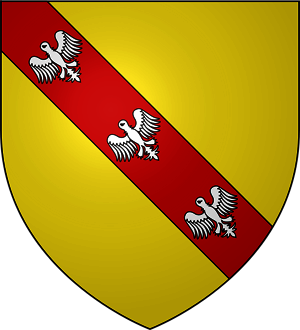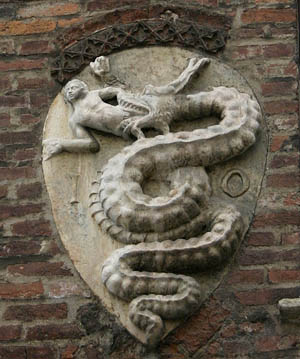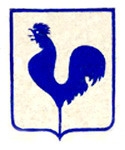 |
Stories & Legends
The Arms of Lorraine & Visconti
Elaine M. Jordan
Heraldry came into its own in the Crusading Age. Now, the use of personal and family insignia is ancient (it is mentioned by Homer), but heraldry proper is a feudal institution developed by nobles using personal insignia on seals and shields that came to be transmitted to their families.
The practice of placing the family emblems on the surcoat, or tabard, worn over chain mail in the 13th century accounts for the term "coat of arms." With the closed helmet, this insignia was the only means of identification on the battlefield, and later in the tournaments that drew together knights from many countries.

A coat of arms of Lorraine; below the Visconti ensign became that of the city of Milan
 |
The stories of how a family’s symbols originated were carefully treasured in Europe by the posterity of the bold and victorious ancestors who fought in Palestine.
The arms of Lorraine claim to go back to a legend of Godfrey de Bouillon, who was named King of Jerusalem after the glorious conquest of that city in 1099.
It is said that before the attack on Jerusalem, he prayed for a sign from God. A man from his army told him to use his bow to kill a bird in the sky. When Godfrey shot the arrow, he did not kill one but three birds with the single arrow.
This was the sign from God of the future victory, and Godfrey did capture Jerusalem, as we all know. To commemorate that sign, Godfrey added the three alerions to the red bend of his shield.
Simon II, Duke of Lorraine, already used these arms on a seal dated 1183. All further dukes used them until the incorporation to France in 1766. The Dukes of Lorraine proudly claim to be descendants of Godfrey of Bouillon, who was Duke of Lower-Lorraine (Lothier) from 1089 to 1095.
Among the Italian stories connected with the Crusades is that of Otho Visconti, the founder of that famous Italian family which for centuries possessed sovereign power in Italy as Lords of Milan and Dukes of Lombardy.
The tradition preserved in that family is that in the first Crusade, Otho conquered a huge Saracen, and took from him his shield. On it was a serpent crowned and devouring a child. He adopted it as his own coat of arms.
In the first Canto of the epic poem Jerusalem Delivered by Italian poet Torquato Tasso, we find Godfrey of Bouillon reviewing the Catholic chiefs and their troops. When he comes to Otho Visconti, he makes mention of his famous shield:
“Nor to the strong Otho be the verse denied,
“Otho, who conquered from the Pagan wild,
“The shield whereon the snake devours a naked child.”
This crowned serpent became not only the arms of his family, but has remained ever since the ensign of the city of Milan and the Province of Lombardy. You can see it today throughout the city of Milan.
It was in this and similar ways that many of the early shields originated.

Posted June 25, 2011


Related Topics of Interest
 The Legend of the Ermine of Our Lady The Legend of the Ermine of Our Lady
 The Prayers of a Knight The Prayers of a Knight
 Courage and Obedience Courage and Obedience
 Sultan Saladin Describes the Crusaders Sultan Saladin Describes the Crusaders
 Simon de Montfort’s Good Habit Simon de Montfort’s Good Habit
 Understanding the Crusades Understanding the Crusades
 The Middle Ages, a Forest Filled with Symbols The Middle Ages, a Forest Filled with Symbols

Related Works of Interest
| |
|
Legends | Religious |
Home | Books | CDs | Search | Contact Us | Donate

© 2002-
Tradition in Action, Inc. All Rights Reserved
|
 |
|